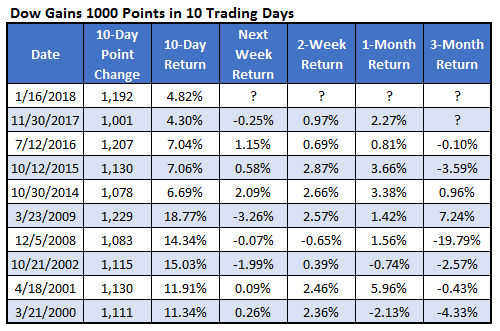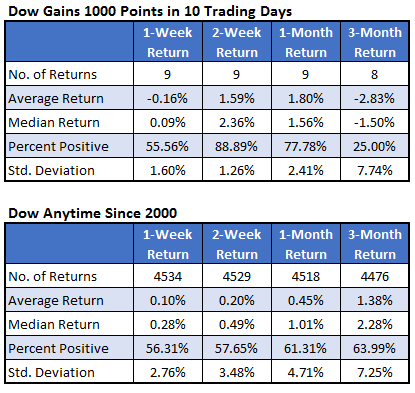This Dow Signal Flashed in March 2009
U.S. stocks have been crushing it in 2018, with the major market indexes assailing new heights at a crazy clip, sending stock market inflows and Wall Street optimism skyrocketing. In fact, the Dow Jones Industrial Average (DJI) has already added more than 1,000 points in the first 10 trading sessions of the year, and is pacing for its biggest monthly percentage gain since November 2016. But can the blue-chip stock index maintain this pace, or is a correction on the horizon?
There have been just nine other times in history in which the Dow has soared more than 1,000 points in the span of 10 sessions, the last occurring in late November 2017. There was one signal per year in 2016, 2015, and 2014, but prior to that you'd have to go back to March 2009 -- widely known now as the "bottom" of the financial crisis. The first signal ever occurred in March 2000, per data from Schaeffer's Senior Quantitative Analyst Rocky White.

Although the average three-month returns are widely skewed by the December 2008 signal, after which the DJI dropped nearly 20% into the aforementioned March 2009 bottom, the data suggests some blue-chip weakness ahead. Three months after previous quick, 1,000-point rallies, the Dow was in the red 75% of the time, averaging a loss of 2.83%.
Even removing the 2008 data, the DJI was down 0.4%, on average, three months later. That's compared to an average anytime gain of 1.38%, with a nearly 64% win rate, looking at data since 2000. Only after the 2009 and 2014 signals was the DJI higher three months out.
In the short term, however, strength could beget strength for the Dow. Two weeks after previous signals, the index was up 1.59%, on average, and higher nearly 89% of the time. That's roughly eight times its average anytime two-week gain of 0.2%, with a win rate under 58%.
Likewise, one month after gaining 1,000 points in 10 sessions, the Dow was up 1.8%, on average, and higher nearly 78% of the time. That's more than three times its average anytime one-month return of 0.45%, with a win rate of 61.31%.
